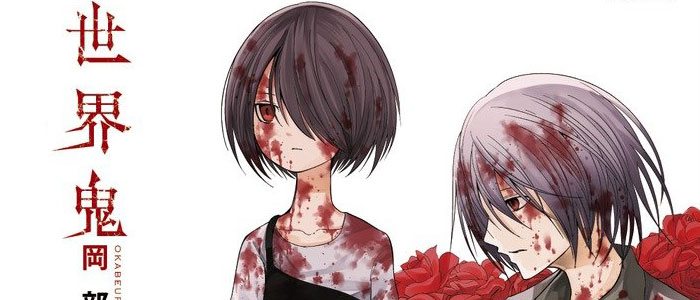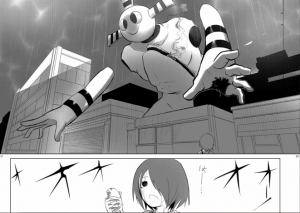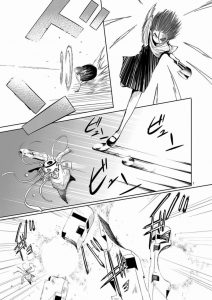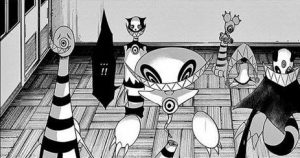You probably haven’t heard of it.
Disclaimer: Sekai Oni is not nice or fluffy. Content at the core of its story includes rape, incest, child abuse, drug usage, suicide, sexually explicit material, and a great ol’ heaping of death. Also, spoilers.
Alice in Mirrorland syndrome: a disease where the afflicted not only see the monsters and demons lurking behind mirrors, but can interact with them. For seven residents of Japan, this disease seems to bring nothing but unhappiness and disaster. However, it is also a necessary tool that allows them to fight the “world devils” threatening to destroy the planet. The result of this fight may bring even greater unhappiness and disaster, or alternately, their world may be destroyed.
Sekai Oni (世界鬼, “World Devil”) is an eleven volume series that focuses primarily on Azuma Shinonome, a fourteen year old girl abandoned by her mother and left in the “care” of her abusive uncle and aunt. She, along with six others, are pulled into a bizarre land behind the mirror by a strange-looking being who calls himself Cheshire Devil and his world, Wonderland. And with that, they are thrown into battle against the first of the World Devils. Quickly, they discover the ability to manifest items in Wonderland and use their new weapons to kill the creature trying to kill them. But some time later, they discover it comes at a cost: the life of someone close to them. When Azuma discovers this, she gleefully sets out on a mission to slay all the remaining World Devils in the hopes of killing every member of her terrible family.
Among this mission and its psychological impact, the stories of the other characters are revealed in pieces: Adachi, a part-timer who fell in love with a girl behind the mirror; Utou, a manga geek who tramples heroic idealism with real-world cynicism; Saki, the co-dependent girl reliant on her roommate; Kuroe, the high-schooler addicted to sex; Ookura, the former JDSF soldier and current inmate with a drug addiction; and Seki, the silent man whose only interest seems to be protecting Azuma. Each of their stories not only involve grappling with the World Devils and potential deaths of their family, but their own personal demons and real-life circumstances.
Alice in Mirrorland syndrome, of course, is a made-up disease. However, the mental illnesses these characters suffer from–trauma, depression, and codependency–are very real. It’s not presented as set dressing, nor are they “psycho” villains. As someone with mental illness, the portrayal of these characters, often let down by the medical system, doing the most harm to themselves, struck a chord with me. And though each of them does confront and eventually triumph over their personal struggle, it’s not a “everything is fixed, happy ending now” result. At the very end of the story, some of those characters are shown to be not cured, but coping.
One character whose story is particularly impactful is Adachi’s. Presented as the Only Sane Man among more dysfunctional and ill people, he at first comes off as a poor victim who spends a good deal of the first few nights injured or unconscious. (Interestingly, his injuries are later relevant to the plot.) His impact comes more toward the back part of the story, providing normal sympathy and normal anger against an increasingly abnormal world. He is the first of the group that Azuma manages to emotionally connect with. When he later finds out she’s the one that’s been killing the World Devils, he is horrified and takes the other adults to task for letting a kid bear such a burden. Normally, the Only Sane Man trope is presented for comedic purposes, reminding us of the normal rules, but non-unconscious Adachi also acts as an anchor of normal morals for the other characters. Whereas they draw sympathy from their traumatic backstories and tragedy, Adachi draws people in with his heartfelt, unironic normalness.
That unironicness is perhaps the brightest, most clear-cut morality in a cast painted in gray. Although the abusive elements are universally condemned, the non-abusive characters are not presented as “good” or “bad.” Of the main cast, the most irredeemable would seem to be the drug-addict prisoner, Ookura, but he is the first to leap to anyone’s defense regardless of circumstances, and his drive to do good even in spite of his flaws is inspiring to the other characters. Meanwhile, one of the World Devils who actually speaks, Giger, is portrayed with humanity and even reveals that the plan to destroy Earth is solely to save their own.
Even the Cheshire Devil is portrayed with complexities: compassion toward his comrades, willingness to use the Alice in Mirrorland afflicted people as pawns, revenge toward the World Devils, and an ultimately pitiful attachment to Wonderland. Because of this, it’s not one of those stories that has an overarching theme or lesson as its core. Not all the characters overcome their personal problems in triumphant force, but bow to meek acceptance bordering on despair. Even as Azuma makes emotional connections to the others and finds some measure of happiness, it’s not like she’s suddenly discovered the meaning of life or shows respect for it at all. Strangely, the most villainous of the characters may be the one that has the “happiest” ending by finding a despair so deep he can finally claim it as his own.
Visually, the art is clean and stylish, leaning into stylized toward particularly emotional moments. One of my favorite visual elements is all the aspects of the mirror people: the monsters, the World Devils, and the Cheshire Devil, which all lend a sense of bizarreness and visual imbalance to a story that deals with mental and emotional imbalance. The artist also uses the mirror reflections to touch on some of the darker elements without having to put them down in horrifying detail. Similarly, the use of the abnormally-geometric cracks in the mirrors is a visual element of the fissures and increasing stress both that the two worlds are physically manifesting and that the characters are reaching as the climax approaches. Light and darkness are both recurring themes that present themselves in the art as well as the story.
With most of the characters having at best bittersweet endings, Sekai Oni is, unsurprisingly, more toward tragic than happy. But it is fulfilling. Each character does have an end to their arc that is reinforced by the way they live their life. And those arcs neither applaud nor vilify the cast. Sekai Oni, a story named for devils, is a story that presents humanity without comment. If this appeals to you, the entire series (in Japanese) is available on Amazon. The first chapter is also available to read on Ura Sunday’s website.




